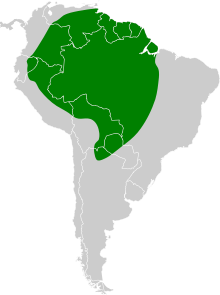Orinoco goose
| Orinoco goose | |
|---|---|

| |
| Scientific classification | |
| Kingdom: | Animalia |
| Phylum: | Chordata |
| Class: | Aves |
| Order: | Anseriformes |
| Family: | Anatidae |
| Genus: | Neochen |
| Species: | N. jubata
|
| Binomial name | |
| Neochen jubata (Spix, 1825)
| |

| |
The Orinoco goose (Neochen jubata) is a member of the duck, goose and swan family Anatidae. It is in the shelduck subfamily Tadorninae, and placed in the genus Neochen. Three fossil relatives have been described from Pleistocene sites: Neochen pugil from Brazil, Neochen debilis from Argentina and Neochen barbadiana from Barbados.
Based on a molecular phylogenetic study published in 2014, some authorities place this species together with the Andean goose in the resurrected genus Oressochen.[2][3][4]
Description[]
Orinoco geese are typically 61 to 76 cm (24 to 30 in) long. They have pale heads and necks, chestnut flanks and mantles and blackish wings with white speculae. Their legs are red, their bills black and pinkish. The sexes are identical in plumage, though the males are larger; juveniles have duller plumage.
Males have high pitched whistling calls, and females cackle like the related Egyptian goose.
Distribution and habitat[]
The Orinoco are resident breeders in the forests of tropical South America. Largely terrestrial, they also perch readily in trees. They rarely swim or fly, unless hard-pressed. In flight, they look heavy, more like geese than ducks, hence the English name. They prefer forest lakes or marshes with access to open woodland or savanna, or beaches with direct access to river channels. They are more rarely seen in tributary areas.
Orinoco geese have escaped or been deliberately released into Florida, where there is no evidence they breed, persisting rather due to continual releases and escapes.[5]
Migration and parasites[]
The Orinoco geese are very territorial in the breeding season, and usually nest in hollow trees, only occasionally on the ground. Manú National Park in Peru is known to have an established population, of particular interest for its disappearance during the wet season. Roughly 12% of the Manú National Park Orinoco geese migrate during the wet season after breeding during the dry season. They were found to migrate to the Llanos de Moxos in Bolivia, with movements of over five kilometres undertaken at night. The pattern indicates they move mostly longitudinally, and that partial migration plays an important role, maybe showing the evolutionary transition from sedentariness to complete migration.[6]
The migration of Orinoco geese may also spread disease. Toxoplasma gondii and Neospora caninum are both apicomplexan parasites that infect various animals and cause severe disease. They thrive in fields where Orinoco geese forage during stopovers during migration. Once birds are infected, they can transmit the parasites to other birds or humans. Orinoco goose meat is eaten by people in Bolivia and Brazil, leading to the contamination of nearby food.[7]
Status[]
In order to protect these birds, conservation efforts focus on river margins, sandy beaches along the main river channel and migration routes. [8]
References[]
- ^ BirdLife International (2016). "Neochen jubata". IUCN Red List of Threatened Species. 2016: e.T22679987A92837649. doi:10.2305/IUCN.UK.2016-3.RLTS.T22679987A92837649.en. Retrieved 12 November 2021.
- ^ Bulgarella, M.; Kopuchian, C.; Giacomo, A.S.D.; Matus, R.; Blank, O.; Wilson, R.E.; Mccracken, K.G. (2014). "Molecular phylogeny of the South American sheldgeese with implications for conservation of Falkland Islands (Malvinas) and continental populations of the Ruddy-headed Goose Chloephaga rubidiceps and Upland Goose C. picta". Bird Conservation International. 24 (1): 59–71. doi:10.1017/S0959270913000178.
- ^ Jaramillo, Alvaro (July 2014). "Proposal 637: Treat Chloephaga melanoptera and Neochen jubata as congeners". South American Classification Committee, American Ornithologists' Union. Retrieved 12 June 2021.
- ^ Davenport, L.; Endo, W.; Kriese, K. (2020). Schulenberg, T.S. (ed.). "Orinoco Goose (Oressochen jubatus), version 1.0". Birds of the World. Ithaca, NY, USA: Cornell Lab of Ornithology. doi:10.2173/bow.origoo1.01. S2CID 216415094. Retrieved 12 June 2021.
- ^ http://myfwc.com/wildlifehabitats/nonnatives/birds/orinoco-goose/
- ^ Davenport, Lisa (2012). "East with the Night: Longitudinal Migration of the Orinoco Goose (Neochen jubata) between Manú National Park, Peru and the Llanos de Moxos, Bolivia". PLOS ONE. 7 (10): e46886. Bibcode:2012PLoSO...746886D. doi:10.1371/journal.pone.0046886. PMC 3464272. PMID 23056512.
- ^ André, Marcos Rogério (2019). "Serological evidence of exposure to Toxoplasma gondii and Neospora caninum in free-ranging Orinoco goose (Neochen jubata) in Brazil". Rev Bras Parasoitol. 28 (4).
- ^ Endo, Whaldener (2014). "Seasonal abundance and breeding habitat occupancy of the Orinoco Goose (Neochen jubata) in western Brazilian Amazonia" (PDF). Bird Conservation International. 24 (4): 518–529. doi:10.1017/S0959270914000173. S2CID 83968707.
External links[]
 Media related to Neochen jubata at Wikimedia Commons
Media related to Neochen jubata at Wikimedia Commons Data related to Neochen jubata at Wikispecies
Data related to Neochen jubata at Wikispecies
WHALDENER ENDO (a1) (a2), TORBJØRN HAUGAASEN (a1) (a2) and CARLOS A. PERES (a3) https://doi.org/10.1017/S0959270914000173P
- IUCN Red List near threatened species
- Geese
- Neochen
- Birds of Venezuela
- Birds of the Guianas
- Birds of the Amazon Basin
- Birds described in 1825
- Birds of Brazil
